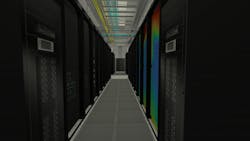Are You Ready for the Storm About to Hit the Data Center Industry?
The data center industry is gearing up for the perfect storm: extreme high-density racks, lack of available space and power for new data centers, extreme competition for leasing new space, increasing governmental regulations on energy, water, and carbon usage, and community concerns regarding the build of new data centers. How do we even begin to tackle these intersecting pain points?
If you’re not lucky enough to pre-lease space in the next colocation site or get the green light to build your own, the only choice is to optimize your facilities. A campus-wide digital twin for data centers is one way to revolutionize performance and efficiency.
Simulate the Entire Data Center Ecosystem for Performance Gains
A digital twin model, such as Cadence Reality DC (formerly 6SigmaDCX by Future Facilities), creates a digital replica of the data center. This replica simulates and visualizes the entire data center ecosystem using BIM-enabled data halls connected to each other and their external environments. Data halls that share cooling, power, or data infrastructure can be connected to each other and their outside environment to capture the entire system’s performance. For example, Cadence Reality DC’s external environments include over 9,000 global ASHRAE weather stations, extreme annual conditions, wind rose data, and more.
Creating a digital twin model with a system like Cadence Reality DC is straightforward because the software intelligently imports objects, i.e., the objects know how to behave and interact with other objects. These objects include cables, pipes, ducts, chillers, generators, cooling towers, buildings, and more. Similarly, model upkeep is automated by integrating data feeds from popular operational tools, including data center infrastructure management (DCIM), BMS, environmental monitoring systems, and CSV spreadsheets.
A digital twin like Cadence’s can model any data center configuration, including complex cooling strategies for air, liquid, hybrid, and modern control systems. Data center teams can use this type of software to test how performance will change over time and simulate critical power and cooling failure scenarios. It’s key that the system be designed to give teams the insights necessary to maximize performance with available resources to weather the impending storm in the data center industry.
New AI and ML Features
A built-in expert system that can automatically identify cooling issues, assess the state of the data center's digital twin model, and recommend potential fixes is also key. Data center professionals can then select the fixes they deem appropriate, and the system will incorporate the changes into a new version of the digital twin model. Because a digital twin is a simulated environment, changes can be tested virtually, ensuring the live facility will be completely safe, and teams can select the most effective, efficient strategy to move forward.
As hardware becomes more sophisticated, so do the in-built library items within many digital twins. For example, IT equipment can be modeled using AI training through Cadence software simulations and manufacturer test data. The AI models can capture complex fan control schemes, predict internal temperatures of CPUs, GPUs, and hard disk temperatures, capture the thermal response to varying IT workloads, and predict thermal throttling behavior caused by the conditions inside the data center. Cadence Reality DC is smart and continues to get smarter with each new release, aiming to automate menial tasks so data center managers can focus on the high-level decisions that matter.
Weather the Storm with Cadence Reality DC
This isn’t the first time the data center industry has experienced such challenges, and it won’t be the last. The good news is that challenges can also be opportunities. This perfect storm is an opportunity to optimize our facilities to be as efficient, flexible, and powerful as possible. Cadence Reality DC helps data center teams face new challenges head-on with clear visibility of the entire data center ecosystem.
Learn more about Cadence Reality DC by visiting the data center solutions page.
About the Author

Mark Fenton
Mark Fenton, Product Engineering Director at Cadence Design Systems, has accrued over 20 years’ experience pioneering the use of computational fluid dynamics (CFD) in the data center design and operations industry.
Cadence is a leader in electronic systems design, building upon more than 30 years of computational software expertise. The company applies its underlying Intelligent System Design strategy to deliver software, hardware, and IP that turn design concepts into reality. Cadence acquired Future Facilities in 2022 for its expert 6SigmaDCX and 6SigmaET simulation software suites to expand its electronics product portfolio and facilitate energy efficiency and performance optimization for the data center industry through digital twin technology – now Cadence Reality DC.



